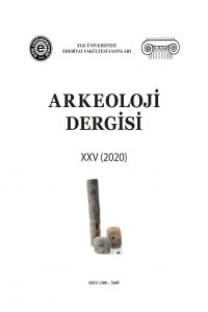Klaros Lyralı Apollon Figürinleri Üzerine Bir Tipoloji
Apollon Klarios kutsal alanından ele geçmiş olan çeşitli tiplerdeki figürinler içinde, sol elinde lyra taşıyanerkek figürinleri özel bir öneme sahiptir. Söz konusu figürinler temelde ortak özellikler gösterse de detaylardaki stilistik farklılıklar ile birbirlerinden ayrılırlar. Klaros lyralı Apollon figürinlerinde yedi ayrıtipolojik grup saptanmıştır. En erken tipler, Tip I, Tip II ve Tip III olup İ.Ö. 6. yüzyılın sonuna tarihlenirler. İ.Ö. 5. yüzyıl içinde Tip IV, Tip V ve Tip VI bulunur. Son grup ise İ.Ö. 4. yüzyıla tarihlenen Tip VIIdir.
A TYPOLOGY on APPOLLON FIGURINES with LYRE
Among the figurines found at Apollo Clarios Sanctuary, male figures carrying lyre on their left hand havea special importance. Although these figurines have common characteristics basically, they have differentstylistic features. Among the Claros figurines carrying lyre, seven different types have been determined.The earliest types dated to late 6th century B.C., are type I, II and III. In the 5th century BC, appeared typeIV, V and VI. The last type is type VII which is dated to 4th century BC.
___
- Baudat 1953: B. Baudat, Terres Cuites de lÉcole Française dAthènes, BCH, 77, 1-45.
- Blınkenberg 1931: Ch. Blinkenberg, Lindos. Fouilles de lAcropole 1902-1914. I. Les Petits Objets, Berlin.
- Boardman 2001: J. Boardman, Yunan Heykeli. Arkaik Dönem, (çev. Yaşar Ersoy), Homer Kitapevi.
- Boardman 2005: J. Boardman, Yunan Heykeli Klasik Dönem (çev. Gürkan Ergin), Homer Kitapevi.
- Büyükkolancı ve Doğan 2007: M. Büyükkolancı E. Doğan, Efes Ayasuluk Tepesinde Bulunan Figürinler, ADerg 9, 123-133.
- Dewaılly 2000: M. Dewailly, Les statuettes en terre cuite du sanctuaire dApollon à Claros: Production et consommation ( fin VIème -fin Vème siè- cle), içinde: F. Krinzinger (ed.), Die Ägäis und das westliche Mittelmeer. Beziehungen und Wechselwirkungen 8.bis 5. Jh. v. Chr., Wien, 24. bis 27. März 1999, 343-347, Viyana.
- Hıggıns 1969: R.A. Higgins, Catalogue of the Terracottas in the Depart ment of Greek and Roman Antiquities British Museum, Volume I, Greek: 730- 330 B.C., London.
- Işık 1980: F. Işık, Die Koroplastik von Theangela in Karien und Ihre Beziehungen zu Ostionien (zwishen 560 und 270 v. Chr.), IstMitt Beiheft 2 1, Tübingen.
- Karakası 2004: K. Karakasi, Archaic Korai (ing. çev. J.P.G. Trust), Los Angeles.
- Köster ve Kossatz 1980: R. Köster, A.U. Kossatz, Ausgewählte Funde, Terrakotten vom Humeitepe, IstMitt 30, 49-55.
- Merker 2000: G.S. Merker, Corinth 18-4. The Sanctuary of Demeter and Kore. Terracotta Figurines of the Classical, Hellenistic, and Roman Periods, Princeton.
- Mollard-Besques 1954: S. Besques-Mollard., Musée national du Louvre, Catalogue raisonné des figu- rines et reliefs en terre cuite grecs, étrrusques et romains I, Epoques préhellénique, géometrique, archaїque et classique, Paris.
- Monloup 1994: T. Monloup, Salamine de Chypre XIV. Terres Cuites Classiques. Un Sanctuaire de la Grande Déesse, Paris.
- Özgan 1978: R. Özgan, Untersuchungen zur archais- chen Plastik Ioniens, Bonn.
- Rıchter 1960: G.M.A. Richter, Kouroi: Archaic Greek Youths. A Study of the Development of the Kouros Type in Greek Sculpture, London.
- Rıchter 1968: G.M.A. Richter, Korai: Archaic Greek Maidens, London.
- Rıdgway 1977: B.S. Ridgway, The Archaic Style in Greek Sculpture, Princeton.
- Robınson 1933: D.M. Robinson, Excavation at Olynthus. Part VII: The Terracottas of Olynthus found in 1931, London.
- Senff 1993: R. Senff, Das Apollonheiligtum von Idalion: Architektur und Statuenausstattung eines Zyprischen Heiligtums, SIMA 94, Jonserd.
- Szabo 1994: M. Szabo, Archaic Terracottas of Boeotia, Rome.
- Şahin 2005: M. Şahin, Terrakotten aus Knidos: Erste Ergebnisse Die Kulte auf der Rundtempelterrasse, IstMitt, 55, 65-93.
- ISSN: 1300-5685
- Yayın Aralığı: Yılda 2 Sayı
- Başlangıç: 1991
- Yayıncı: Ege Yayınları
